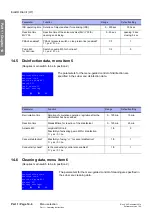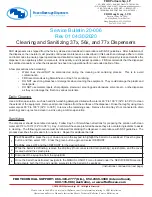
Rev. 4.00 December 2014
Software version 1.04
Part 1 • Page 12-18
Disinfection / Cleaning
Part 1 – Operating Instructions
EcoRO Dia I/II (HT)
Part 1 • Chap
ter 12
2/7
1.43321
Sodium Hydroxide, 30%
Composition/information on ingredients
Name
CAS number
% by weight
3 .
Water
7732-18-5
70
Sodium Hydroxide
1310-73-2
30
Call medical doctor or poison control center immediately. Wash out mouth with water.
Do not induce vomiting unless directed to do so by medical personnel. Never give
anything by mouth to an unconscious person. Get medical attention immediately.
Check for and remove any contact lenses. Immediately flush eyes with plenty of water
for at least 15 minutes, occasionally lifting the upper and lower eyelids. Get medical
attention immediately.
In case of contact, immediately flush skin with plenty of water for at least 15 minutes
while removing contaminated clothing and shoes. Wash clothing before reuse. Clean
shoes thoroughly before reuse. Get medical attention immediately.
Move exposed person to fresh air. If not breathing, if breathing is irregular or if
respiratory arrest occurs, provide artificial respiration or oxygen by trained personnel.
Loosen tight clothing such as a collar, tie, belt or waistband. Get medical attention
immediately.
First aid measures
Eye contact
Skin contact
Inhalation
Ingestion
:
:
:
:
4 .
Use an extinguishing agent suitable for the surrounding fire.
Fire-fighting measures
Extinguishing media
Promptly isolate the scene by removing all persons from the vicinity of the incident if
there is a fire. No action shall be taken involving any personal risk or without suitable
training.
In a fire or if heated, a pressure increase will occur and the container may burst.
Special protective
equipment for fire-fighters
Fire-fighters should wear appropriate protective equipment and self-contained breathing
apparatus (SCBA) with a full face-piece operated in positive pressure mode.
:
5 .
Special exposure hazards
:
None known.
:
Hazardous thermal
decomposition products
:
Decomposition products may include the following materials:
metal oxide/oxides
Flammability of the product
:
Not suitable
:
No action shall be taken involving any personal risk or without suitable training.
Evacuate surrounding areas. Keep unnecessary and unprotected personnel from
entering. Do not touch or walk through spilled material. Do not breathe vapor or mist.
Provide adequate ventilation. Wear appropriate respirator when ventilation is
inadequate. Put on appropriate personal protective equipment (see section 8).
Environmental precautions
Accidental release measures
:
Avoid dispersal of spilled material and runoff and contact with soil, waterways, drains
and sewers. Inform the relevant authorities if the product has caused environmental
pollution (sewers, waterways, soil or air).
Personal precautions
:
6 .
Stop leak if without risk. Move containers from spill area. Approach release from
upwind. Prevent entry into sewers, water courses, basements or confined areas.
Contain and collect spillage with non-combustible, absorbent material e.g. sand, earth,
vermiculite or diatomaceous earth and place in container for disposal according to local
regulations (see section 13). Dispose of via a licensed waste disposal contractor.
Contaminated absorbent material may pose the same hazard as the spilled product.
Note: see section 1 for emergency contact information and section 13 for waste
disposal. Dilute with water and mop up if water-soluble or absorb with an inert dry
material and place in an appropriate waste disposal container.
Spill
:
Methods for cleaning up
Continued on next page
















































